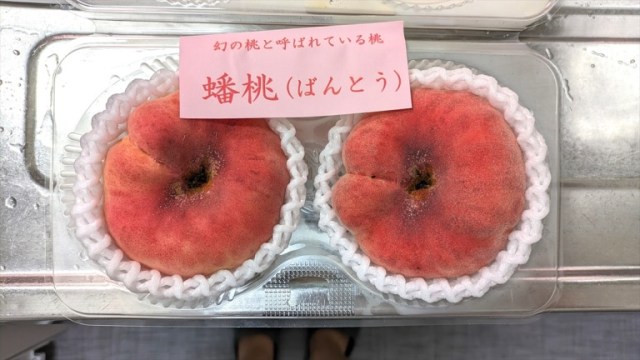
From the literary classic to our stomach.
In Japan, the way food looks is important. That goes not just for plated meals at restaurants, but even the appearance of produce sold at markets. So usually, when you buy peaches in Japan, you can expect them to look like this.
So when we came across a farm in Wakayama Prefecture selling peaches that looked like this…
…you might think we’d have passed them by.
We didn’t, though, because as unusual as they looked, we weren’t about to waste the chance to eat these, because they’re the same kind of peaches eaten by Son Goku.
These are called banto in Japanese, which literally translates to “coiled peaches.” They’re also known in English as flat peaches, and if you’re scratching your head trying to recall which episode of Dragon Ball this kind of fruit showed up in, we should clarify. We’re not talking about Son Goku the anime/manga character, but his original namesake, Son Goku the literary character, from 16th century Chinese novel Journey to the West.
Within the story, Son Goku (also transliterated as Sun Wukong), is tasked with guarding an orchard of peaches in heaven, which grant things such as sagely wisdom and eternal life to those who eat them. When he’s excluded from the banquet where the peaches are to be eaten, though, Son Goku rebels by eating all the peaches, and his punishment sets off a chain of events that eventually leads to his involvement in the titular pilgrimage to the west.
Banto are hard to grow in Japan, so much so that they’re sometimes referred to as “phantom peaches” (not to be confused with the “phantom peach juice” we tried a while back) and their price reflects that. Not that peaches are particular cheap to begin with in Japan; at the farm where we bought out banto, regular peaches were selling for between 500 and 800 yen for a pack of two. Our pair of banto was pricier still, though, at 1,000 yen (US$7.05).
While they have the same color and smell as normal peaches, pre-cutting that’s where the similarities end. Even their stems are funky, looking like little teapot lids.
But though their initial appearance was somehow at once intriguing and off-putting, they get cuter when you slice them in half…
…because their cross-section is heart-shaped. It’s also reassuring to see that the fruit is the same pinkish white as normal peaches, and the pit was easy to remove.
As soon as we started slicing, the comforting and enticing sweet smell of peaches started drifting up to our nose, and the quick change from bizarre shape to such familiar aspects of peach-ness was a surreal combination.
Taking a bite, the first thing we noticed is that banto aren’t as moist as a regular white peach, which gives them a chewier consistency. The mouthfeel is sort of like a more fibrous European pear.
The flavor, meanwhile, is fantastic. It’s pure sweetness, with hardly a hint of any sort of bitter note. What juice the banto does have is thick and syrupy, almost like the peach nectar drinks sold by Japanese confectionary company Fujiya.
So in the end, the weirdness of the banto’s appearance was matched by their deliciousness, and though we don’t have the stomach capacity to eat a whole orchard’s worth like Son Goku did, we definitely could go for two, and even a couple more.
Photos © SoraNews24
● Want to hear about SoraNews24’s latest articles as soon as they’re published? Follow us on Facebook and Twitter!
[ Read in Japanese ]